The other day I showed an elderly couple harvesting rice from a small field with a small combine. Rice has been farmed a lot longer than combines and gasoline have been around, and it's still common to see rice harvested old-school style, especially small fields.
While on yesterday's drive into the mountains northwest of Kyoto, we came upon such a harvest, where the rice plant is cut and hung, rice kernels still attached....
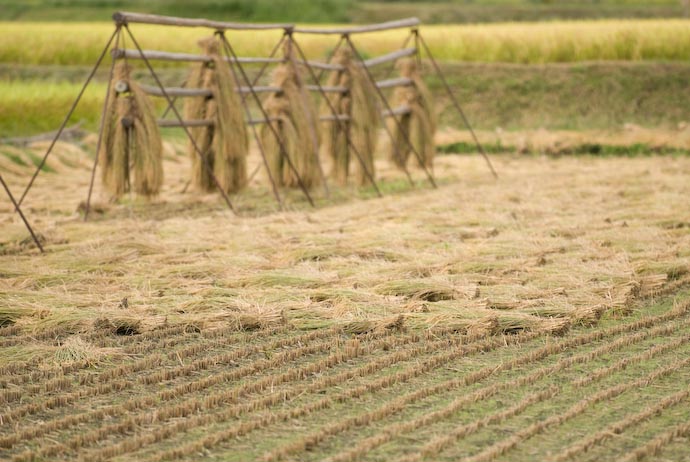
Nikon D200 + Nikkor 70-200mm f/2.8 @ 200mm — 1/1000 sec, f/3.2, ISO 200 — map & image data — nearby photos
The Rice Harvest, Old-Style
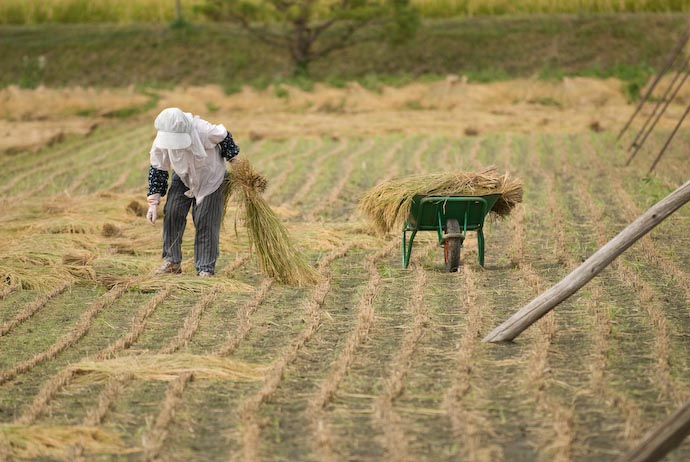
Nikon D200 + Nikkor 70-200mm f/2.8 @ 200mm — 1/1250 sec, f/3.2, ISO 200 — map & image data — nearby photos
Collecting a Rice Bundles
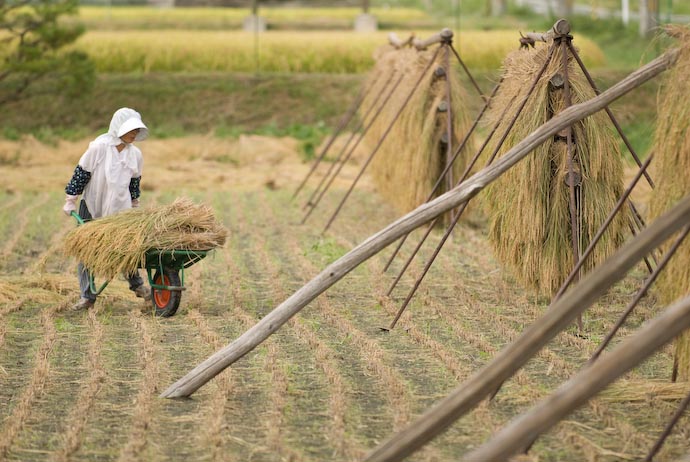
Nikon D200 + Nikkor 70-200mm f/2.8 @ 200mm — 1/1000 sec, f/3.2, ISO 200 — map & image data — nearby photos
Bringing it to The Racks
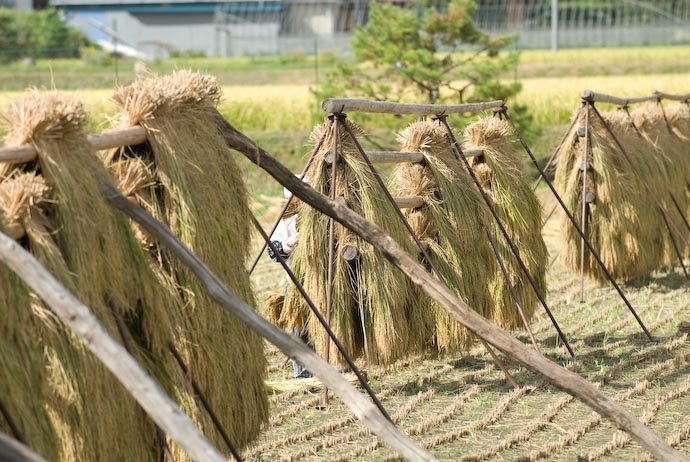
Nikon D200 + Nikkor 70-200mm f/2.8 @ 200mm — 1/350 sec, f/4.5, ISO 100 — map & image data — nearby photos
Hanging Rice
(here, “Hanging” is a verb)
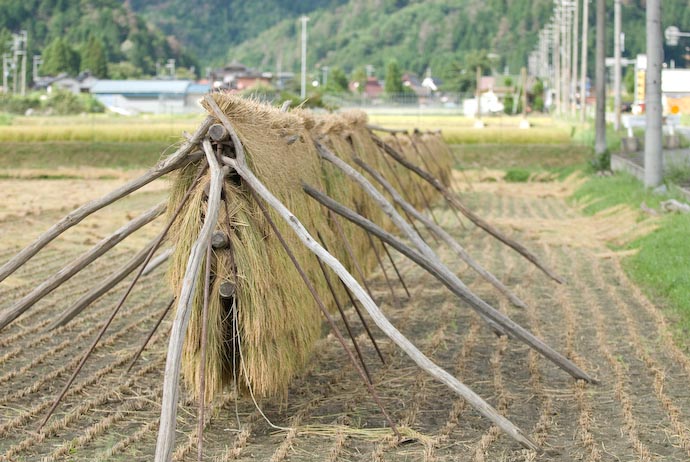
Nikon D200 + Nikkor 70-200mm f/2.8 @ 80mm — 1/1000 sec, f/2.8, ISO 200 — map & image data — nearby photos
Long Field; Lotsa' Rice
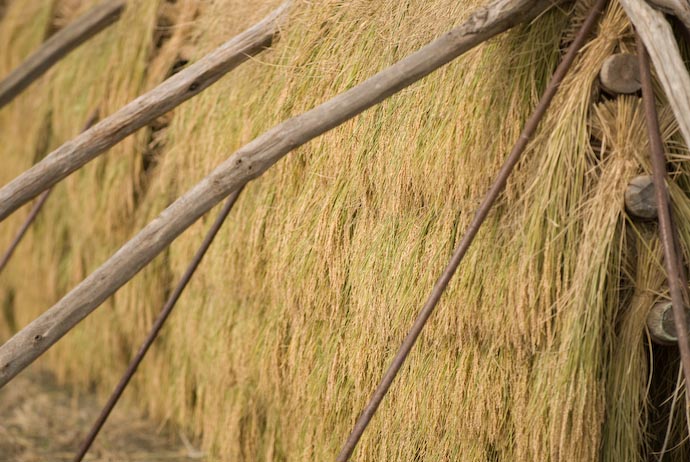
Nikon D200 + Nikkor 70-200mm f/2.8 @ 200mm — 1/1250 sec, f/2.8, ISO 200 — map & image data — nearby photos
Hanging Rice
(here, “Hanging” is an adjective)
It's hard to see the actual rice kernels in the shot above, so below is a full-resolution crop from near the center...
I'm not sure the exact process, but I'd guess that they're hung so that the rice plant will wither, making it easier to separate the rice kernels simply by shaking it. I don't know.
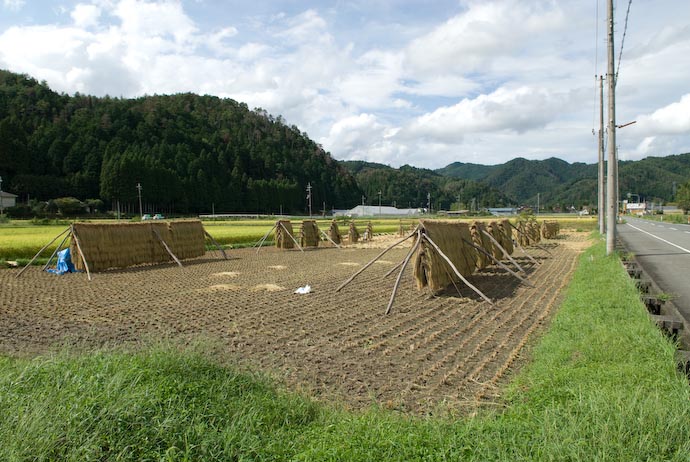
Nikon D200 + Nikkor 17-55 f/2.8 @ 17mm — 1/180 sec, f/8, ISO 100 — map & image data — nearby photos
Entire Field
The next field (not visible, behind me in the shot above) was already harvested, but the one next to it hadn't been started yet, so it made for a pretty picture, It think...
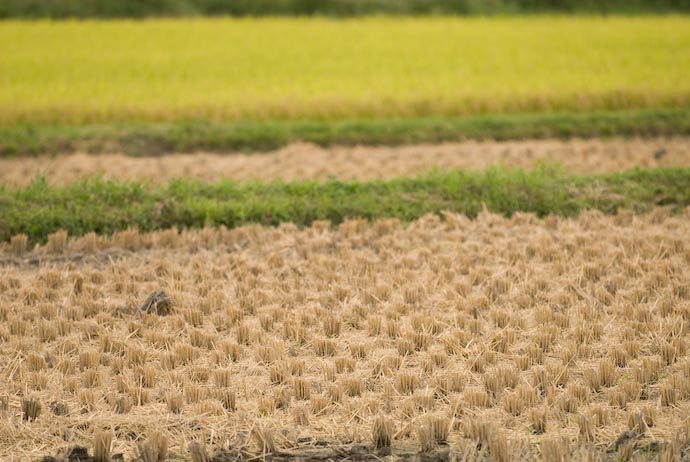
Nikon D200 + Nikkor 70-200mm f/2.8 @ 200mm — 1/1000 sec, f/3.2, ISO 200 — map & image data — nearby photos
Harvested (foreground),
Waiting (background)
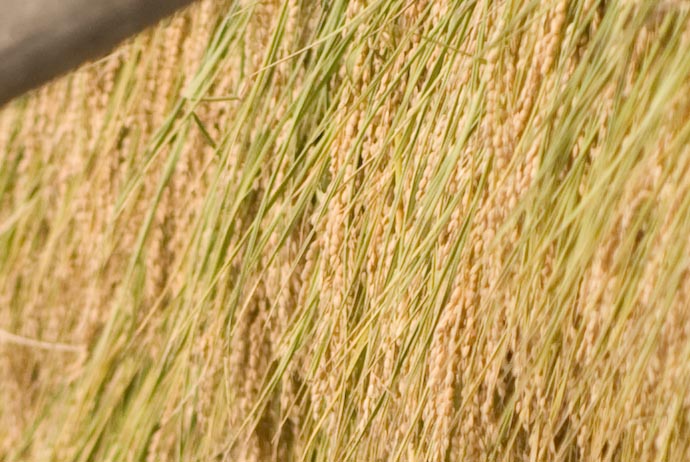
This was very interesting. But I have a couple of questions: Were the bundles of rice first tied together before they were hung over the poles.? I couldn’t get close enough to make it out.
It certainly seems so; I don’t know how else they’d stay up.
Also, I was curious about the method of building the drying frame. I’m sure the poles were lashed together somehow with either rope, twine or vines. Is it possible you could enlarge the first shot showing the construction in more detail?
You know that you can click on the images to see a much-enlarged version, right? 🙂 They seem to use a metal structure to hold up the ends of the poles, with the wood poles strung between. It seems also that they used additional wood support for some of them, but not most.
I don’t suppose you know what the poles were…sumac, willow, maple????
Beyond “wood” I have no idea.
Neat post.
Thanks —Jeffy
Where did you take these? I’ve been meaning to go and take pictures of the same thing.
What I find interesting is the different styles of “hanging” found in different regions.
Never mind, now I see where you took them.
It’s great to see these photographs of the rice picking (inekari), as I went myself and joined a group last weekend to do some inekari in Nagano. We picked it and hung it old-style, so these photos are quite familiar.
I’m a student at a Japanese-language school in Nagano, and every year Nagano-shi send one field of rice to Africa, where they have little money/food. So they look for volunteers to help cut and hang the rice, and our school always send a few people to help.
I’ll try answer a couple of the questions. First the tying of the rice. As you can see in the first photo, the rice is cut and laid in bundles on the ground. Then either strands of rice-less stalks or string (I saw both) are used to tie around the bundle near the base. It’s a case of looping around once, twisting the ends around each other, and then looping the twist through on itself to secure it.
Once the tying is done and it’s ready to hang, the bundle is divided into two – and I heard different people state either 70-30 proportions or 50-50 – by twisting where it’s tied so it forms an upside down V-shape, and then putting this over the pole. You can see this in the 4th/5th photos.
As for the pole, when they were setting them up in our field, it looked to me like a hollow bamboo tube, but I can’t say more than that unfortunately.
Anyway I hope that’s a little informative. If ever you get the chance to do inekari I recommend it. Although quite hard work (especially when it’s really sunny) it’s very rewarding; especially as in our case where it’s going to a really good cause.
Jeffrey, I’m not sure if you remember but I wrote to you a couple of times in the past about various photographic things. Well since June I’ve been living in Japan (in Nagano), and I’m loving it! Not missing the UK much, except for friends/family.
Hello,
I’ve been a somewhat regular reader of your blog but I’ve never commented before. I like your photography and I’ ve been enjoying watching your photos become more and more refined. It also gives me a chance to learn more about Japan.
In this series, I don’t like the first photo. Your focus is on the foreground which is not interesting at all and the only thing that would be interesting is blurred.
Yeah, it doesn’t “work” as well as I’d hoped. I’m still learning.
That being said, you have a fabulous image in this set: “bringing it to the racks”. The composition, the focus, the colours, everything is perfectly into place. Congratulations! It’s been interesting to learn about rice harvesting; thank you for your reportage.
I just have one question though, do the people you photograph mind you taking their picture whilst working?
I don’t know whether they mind, but I’d certainly stop if they gave the slightest indication that they did mind. (One generally doesn’t need permission to snap or publish pictures of people visible to the public, but I’d certainly honor someone’s request not to be photographed.) When shooting for the first harvest post, I was so close to the couple that I felt it appropriate to ask them first. They said sure, it’s fine, but I heard them mumbling “strange” (おかしい) later. Perhaps they wondered why I wanted to take their picture? They were nice, but busy, so we didn’t chit-chat a lot.
Thanks for sharing your photos!
C.
Thanks for your kind words about my blog/photography, and your comments! —Jeffrey
Thanks for the blog in general. I am not a photographer but I do appreciate a good image. I found your site through a Google search of “small combine”. I and many other micro-local U.S. farmers are looking for small combines to fill a demand for locally produced grains. Thanks for the lead….
Mark
Florida in the United States of America. My husband spent a year at Sado Shima, Japan in 1957-1958 and shares his interesting experiences still today. The rice fields and workers are highly respected memories of his. And, his joy is contagioius…I caught it from his pictures and conversations.